|
|
ARTHROPODS:
Insects»
Spiders»
Centipedes»
Millipedes»
Sowbugs»
Harvestmen»
Mites
& Ticks»
Scorpions»
Identification
Tips»
About
the Critter Files»
Links» |
|
|
|
 |
ROBBER
FLIES
Critter
Files/Insects/True
Flies/Robber Flies
By Blake Newton
University of Kentucky Department of Entomology |
| |
|
| Common
Kentucky Robber Flies: |
| |
| TAXONOMY |
KINGDOM:
Animalia | PHYLUM: Arthropoda | CLASS: Insecta | ORDER :Diptera
| FAMILY: Asilidae (robber flies) |
| |
| Other
Names: Asilids |
| |
WHAT
IS A ROBBER FLY?
LIFE CYCLE
ECOLOGY
PEST STATUS
COMMON KENTUCKY ROBBER FLIES
COLLECTING & PHOTOGRAPHY
ROBBER FLY FACTS
MYTHS, LEGENDS, AND FOLKLORE |
| |
| WHAT
IS A ROBBER FLY? |
|
| Robber flies
belong to the family Asilidae. This family includes some of
the largest and most distinctive insects in the order Diptera. Like
all true flies, robber flies have only 2 wings. Robber flies
also have a distinctive hollow space between their 2 large compound
eyes. This characteristic distinguishes robber flies from most
other kinds of flies. |
| |

Above:
Robber fly eyes, showing hollow area at the top
of the head between the eyes. This hollow area is not
present on most other kinds of flies. (B. Newton, 2003)
|
| |
Most robber
flies also have a "bearded" appearance, with fine hairs
covering their long, piercing mouthparts. The most commonly
seen robber flies are dark in color, with gray and black bodies,
but some common types are orange. Other species mimic bumble
bees, with black and yellow stripes.
Larval robber flies are
seldom seen, and are usually found in soil. They are legless
and soft-bodied, and some are fairly large. A robber fly larva
is pictured here
at Florida's Featured Creatures page.
|
|
| SIZE:
Adult robber flies and larvae attain body lengths of up to 1 1/4"
|
| |
| LIFE
CYCLE |
|
Like
all true flies, robber flies and their relatives have complete metamorphosis
with egg, larval, pupal, and adult stages. The larvae are long and
legless and live underground, where they also pupate. Winged
adults are active during warm months.
Robber fly larvae are
seldom encountered or photographed. Pictured below is an illustration
by University of Kentucky Entomology graduate student Sarah Colvin
(this image was modeled from a preserved specimen). The Asilidae
Home Page also has diagrams of robber fly larvae and pupae here:
http://www.geller-grimm.de/genera16.htm
|
| |
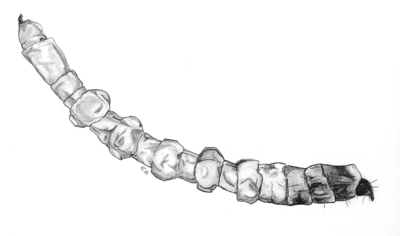 Illustration
of a typical Robber Fly Larva (S. Colvin, 2008)
Illustration
of a typical Robber Fly Larva (S. Colvin, 2008) |
| |
| ECOLOGY |
|
| |
| Larval and adult robber
flies are predators of other insects. The adults are famous
for their ability to capture prey in the air. In fact, robber
flies will often catch insects that are larger than themselves, such
as bumble bees.
|
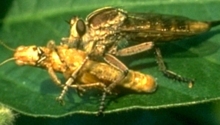 Robber
Fly, feeding on a grasshopper
Robber
Fly, feeding on a grasshopper
(USDA Photo Set) |
| |
Although robber flies
are predators, they
are sometimes prey for other animals, including spiders, birds,
and larger predatory insects like assassin
bugs, praying mantids,
and even other robber flies (as shown below).
|
| |
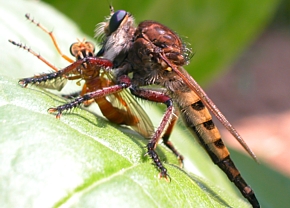 Bearded
Robber Fly feeding on a "Hanging Thief" Robber Fly (L.
Townsend, 2005)
Bearded
Robber Fly feeding on a "Hanging Thief" Robber Fly (L.
Townsend, 2005) |
| |
| Larval robber
flies live in soil and decaying wood where they hunt for insect larvae,
worms, and similar creatures. They
are sometimes eaten by moles and underground arthropods predators,
such as centipedes
and ground beetle larvae. |
| |
| PEST
STATUS |
|
Robber
flies are not normally considered pests. They will occasionally
bite humans, but they are not blood feeders, and will only bite
on accident or if provoked. Because they feed on other insects,
robber flies are generally considered beneficial. However,
they do not specialize on pest insects, and sometimes eat other
beneficial insects, such as bees or other predators.
|
| |
| COMMON
KENTUCKY ROBBER FLIES |
|
|
BEARDED
ROBBER FLIES, BEE KILLERS
GENUS: Efferia,
Promachus, others
These robber flies are
called "Bearded Robber Flies" because
of the many stiff hairs located around the mouthparts. Some
are also called "Bee Killers" because
they are often observed catching bumble bees. Most of these
robber flies are over 1" long and have a frightening appearance,
but they will only bite if handled carelessly. They are common
in many habitats during the summer in Kentucky, especially along
trails and in weedy or agricultural areas. |
| |
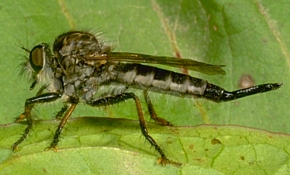 Bearded
Robber Fly (R. Bessin, 2000)
Bearded
Robber Fly (R. Bessin, 2000) |
|
|
|
LAPHRIA
spp.
GENUS:
Laphria
Shown below are two large
(1") robber flies in the Laphria genus.
Many robber flies in this genus closely resemble bumble bees,
with alternating black and yellow patterns. They often capture
and eat bees, just like the bearded robber flies discussed above. |
| |
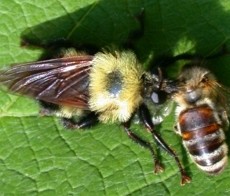 Bumble
bee mimic, Laphria genus,
Bumble
bee mimic, Laphria genus,
feeding on a honey bee (R. Bessin, 2003) |
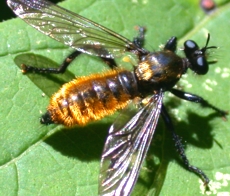 Robber
Fly, Laphria genus (B. Newton, 2004)
Robber
Fly, Laphria genus (B. Newton, 2004) |
|
|
|
HANGING
THIEVES, DIOGMITES spp.
GENUS: Diogmites
Below is a robber fly
from the Diogmites genus. These
large (1") robber flies are very common in row crops during
the summer in Kentucky. They are sometimes called "hanging
thieves" because of their habit of hanging from plants with
their long legs. |
| |
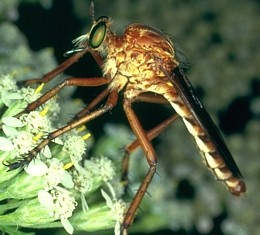 "Hanging
Thief", Diogmites genus (Image courtesy University
of Florida)
"Hanging
Thief", Diogmites genus (Image courtesy University
of Florida) |
| |
| |
|
|
|
SMALL
ROBBER FLIES
GENERA: Cerotainia,
Atomosia, Townsendia, others
Pictured below is a small (1/2") robber fly in the Cerotainia
genus. Kentucky has several small robber fly species in this
and other genera. Although many are common, they are seldom
noticed because of their small size. Just like larger robber
flies, these small species are all predators. |
| |
 Small
robber fly, Cerotainia genus (B. Newton, 2003)
Small
robber fly, Cerotainia genus (B. Newton, 2003) |
|
| |
| COLLECTING
& PHOTOGRAPHY |
|
During the summer and
early fall, robber flies are common in Kentucky, especially along
woodland trails and in agricultural habitats. They are always
on the move, though, and it may take patience to find one. Plus,
they are strong, quick fliers, so an insect net is needed to capture
one. A robber fly will often remain still on a plant or a rock while
a photograph is taken, especially if it is not startled.
|
| |
| MYTHS
- LEGENDS - FOLKLORE |
|
Kokopelli, an important
figure from Native American folklore, is partly named after "pelli,"
a word for the "desert robber fly." Read more about
Kokopelli and his relationship with robber flies at the Kokopelli
Kave website:
www.melhaven.com/kokopelli/kokostory.htm
|
Original document: 25 May 2004
Last updated: 14 Dec 2006
Photos courtesy R.
Bessin, L. Townsend, and B. Newton, University of Kentucky
The Kentucky Critter
Files are maintained by Blake Newton, Department of Entomology, University
of Kentucky.
Contact: blaken@uky.edu
|
|

